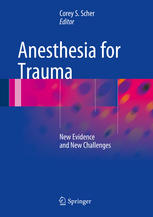Description
“Anesthesia for Trauma: New Evidence and New Challenges” refers to the administration of anesthesia for patients who have experienced trauma, such as injuries resulting from accidents, falls, violence, or other incidents. Trauma patients often require surgery to address their injuries, and anesthesia is a crucial component of their care. Here’s an overview of what you can expect in the context of anesthesia for trauma patients:
- Rapid Assessment:
- Trauma anesthesia providers are trained to quickly assess the extent and severity of a patient’s injuries to determine the appropriate anesthesia plan.
- Emergency Setting:
- Trauma cases often occur in emergency settings, such as trauma bays or emergency departments, where patients require immediate intervention.
- Injury Types:
- Trauma can result in a wide range of injuries, including fractures, head injuries, abdominal injuries, and soft tissue injuries. Anesthesia providers must consider the type and location of injuries when planning anesthesia.
- Patient Stability:
- The patient’s hemodynamic stability and physiological condition play a crucial role in determining the choice of anesthesia. Some patients may require immediate intervention to address life-threatening injuries before surgery.
- Multidisciplinary Team:
- Collaboration with trauma surgeons, emergency medicine physicians, and other specialists is essential for delivering comprehensive care to trauma patients.
- Anesthetic Techniques:
- Anesthesia for trauma can involve various techniques, from general anesthesia for surgery to rapid sequence intubation to secure the airway in critically injured patients.
- Imaging and Diagnostics:
- Trauma patients may undergo imaging studies, such as CT scans or X-rays, to assess the extent of their injuries before surgery.
- Emergency Procedures:
- In some cases, trauma anesthesia providers may be involved in emergency procedures, such as thoracotomies (opening the chest) or craniotomies (opening the skull), to address life-threatening injuries.
- Fluid Resuscitation:
- Trauma patients often require fluid resuscitation to address hypovolemia and maintain blood pressure.
- Pain Management:
- Adequate pain management is important for trauma patients, and anesthesia providers are responsible for ensuring that patients are as comfortable as possible.
- Patient Transport:
- Trauma patients may need to be transported within the hospital or to other facilities for specialized care, and anesthesia providers are involved in ensuring safe transport.
- Evidence-Based Practices:
- The field of trauma anesthesia continues to evolve with new evidence and best practices aimed at improving patient outcomes.
“Anesthesia for Trauma: New Evidence and New Challenges” represents the critical role of anesthesia in addressing the urgent needs of trauma patients. This field requires anesthesia providers to be adaptable, responsive, and skilled in managing a wide range of injuries and conditions. The goal is to provide rapid, effective anesthesia care that supports the surgical interventions needed to save and improve the lives of trauma patients.





Reviews
There are no reviews yet.